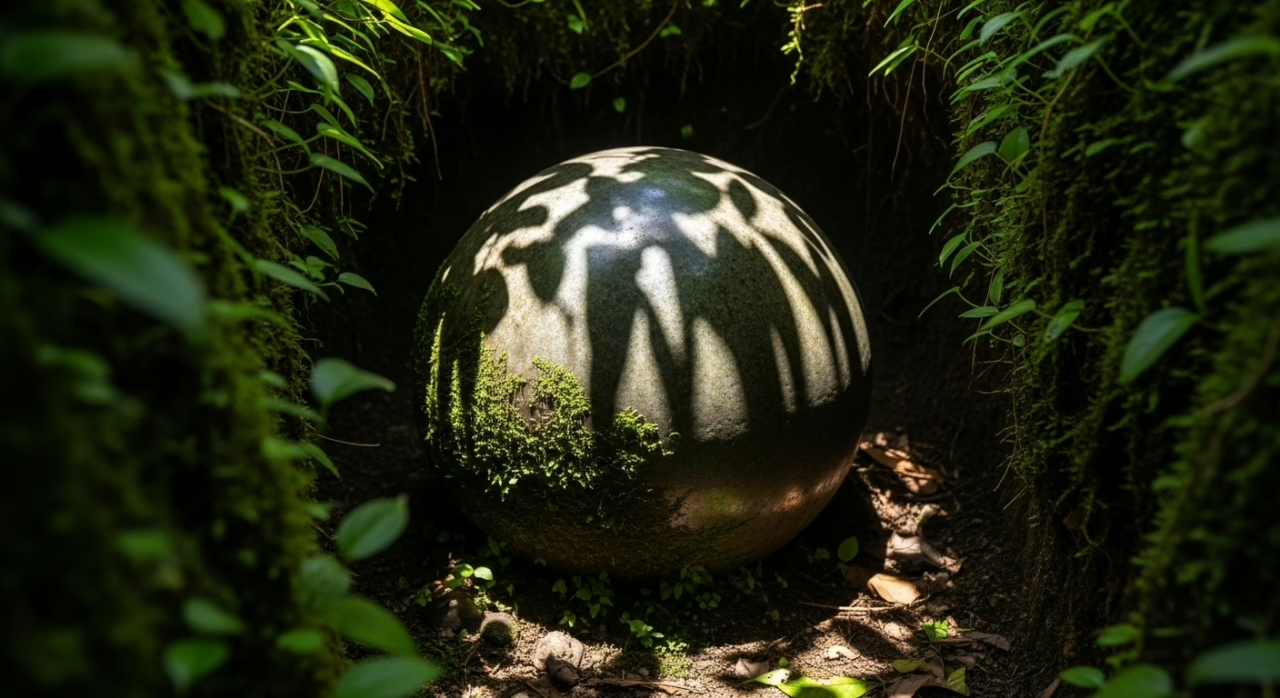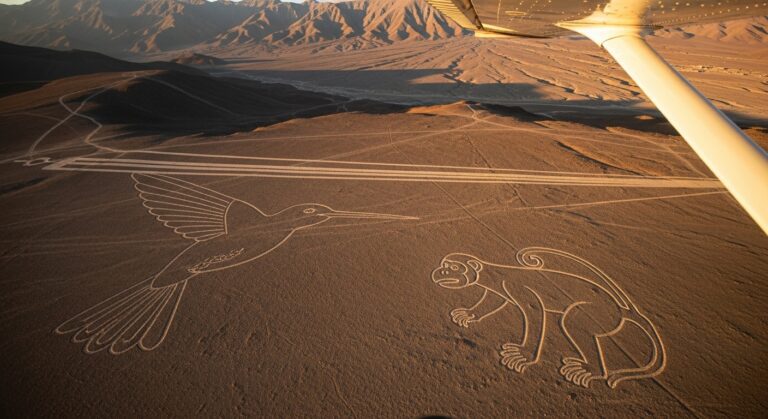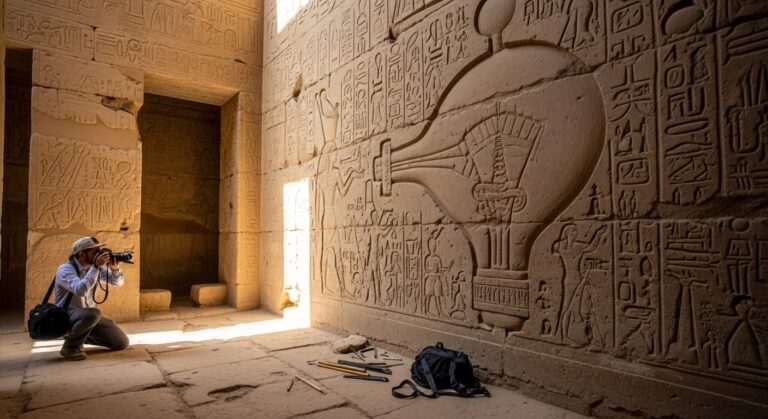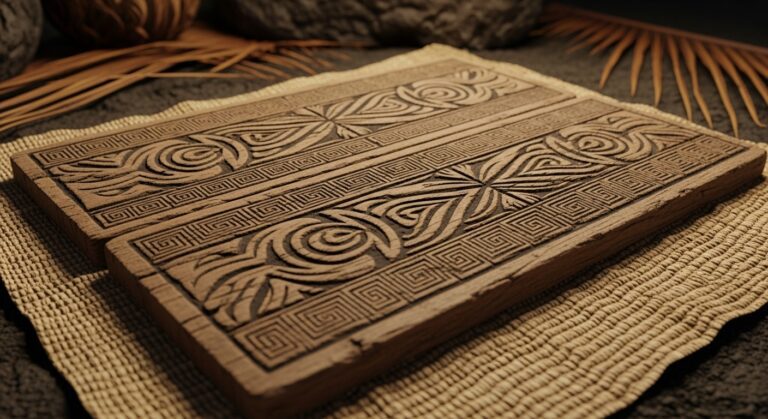The Ancient Stone Spheres of Costa Rica
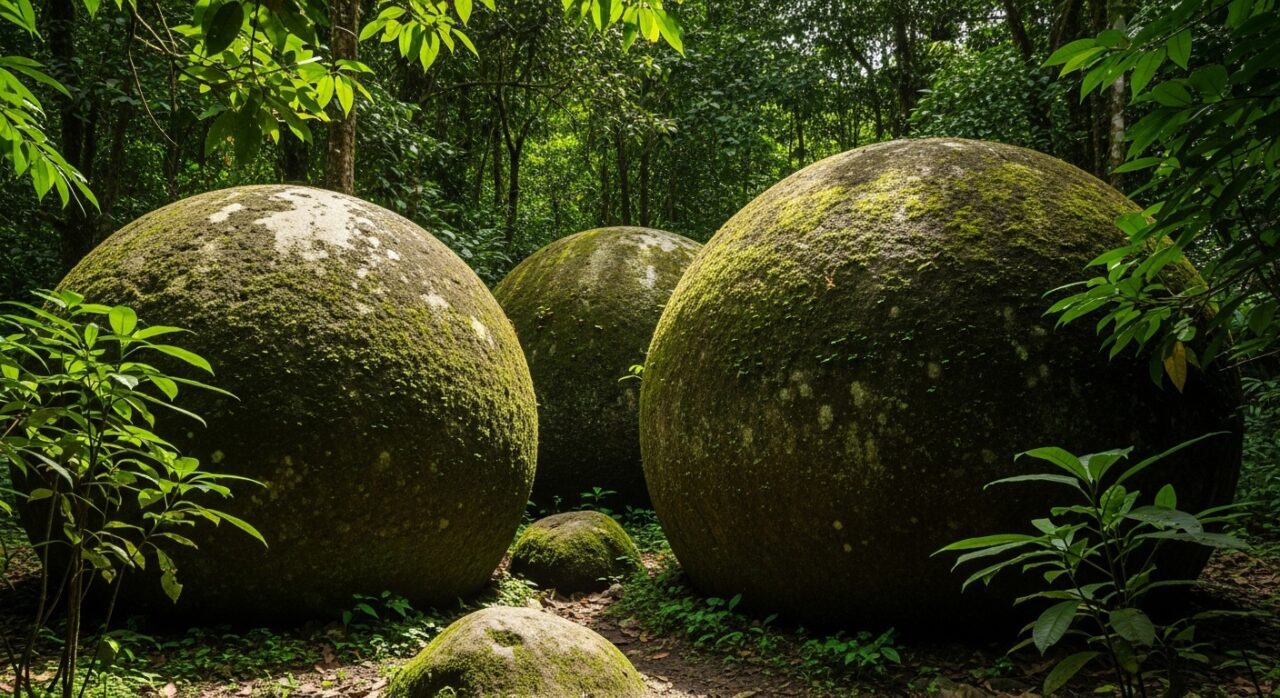
Hidden Secrets of Costa Rica’s Prehistoric Stone Spheres – Hidden beneath dense tropical foliage in Costa Rica’s Diquís Delta lie ancient, perfectly shaped stone spheres, discovered accidentally by banana plantation workers in the 1930s.
Crafted meticulously from solid granite between 500 and 1500 AD, these enigmatic objects have provoked scholarly intrigue and local lore alike.
Yet, who carved these precise sculptures, and for what profound purpose, continues to challenge archaeologists, inviting further exploration into their mysterious origins and symbolic meaning.
Key Takeaways
Hide- Over 300 ancient stone spheres were crafted by the pre-Columbian Diquís culture between 500 and 1500 AD in Costa Rica.
- Primarily located in the Diquís Delta and Palmar Sur regions, the spheres vary from a few centimeters to over two meters in diameter.
- Scholars theorize these spheres served as symbols of social status, territorial markers, or ceremonial objects linked to indigenous spirituality.
- UNESCO designated the spheres and associated archaeological sites as a World Heritage Site in 2014, emphasizing their cultural importance.
- Modern preservation efforts balance local tourism growth with protecting these historical artifacts from environmental damage and urban development.
Historical Discovery of The Ancient Stone Spheres and Early Legends
Long before European scholars turned their curious gaze toward Costa Rica’s mysterious stone spheres, local inhabitants had quietly lived amongst them, woven stories around their origins, and puzzled over their smooth, enigmatic form.
The late 1930s marked a shift, as fruit plantations expanded across the Diquís Delta and work crews unexpectedly excavated these astonishing spheres, sparking intrigue among archaeologists and adventure-seekers alike.
How could such perfectly shaped spheres, silent and imposing, hidden for centuries within jungles and beneath soil, have escaped notice until modern expeditions introduced them to the world’s scholarly attention?
The First Discoveries by Local Inhabitants
Long before archaeologists became involved, local residents in the jungles of Costa Rica encountered these unusually smooth, perfectly rounded stone spheres, hidden among lush foliage or partially submerged in leaf-covered earth.
Indigenous legends emerged, attempting to explain their mysterious origins through intriguing tales of gods, powerful leaders, and celestial phenomena.
Yet, these narratives posed questions that lingered, unanswered: were the spheres symbolic markers of ancestral authority, did they represent cosmic alignments, or was their meaning lost to time entirely?
Early finds and indigenous legends
Occasionally, the most significant archaeological mysteries are uncovered quite unintentionally.
When locals first stumbled across the enigmatic spheres, indigenous beliefs swiftly intertwined with ancient myths, elevating these artifacts into cultural heritage symbols.
Oral traditions recounted impressive stone craftsmanship by unknown ancient civilizations, emphasizing their spiritual significance.
Local legends spread steadily, igniting curiosity and wonder about who skillfully crafted these magnificent, perfect spheres.
- Mysterious origins of ancient stone spheres
- Indigenous legends honoring spiritual significance
- Exceptional quality of stone craftsmanship
- Cultural heritage preserved through oral traditions
- Fascination with secrets of ancient civilizations
Initial interpretations and local myths
When local inhabitants first encountered Costa Rica’s stone spheres in the early 1930s, their imaginations quickly interwove tangible discovery with mythological wonder.
Historical interpretations merged seamlessly with indigenous narratives, attributing mythical origins to the mysterious spheres. Local folklore and ancient legends infused community stories with deep cultural significance, reflecting spiritual beliefs—were these spheres offerings to ancestral deities, or earthly symbols of cosmic harmony?
European Expeditions and Academic Interest
Throughout the early decades of the 20th century, awareness of Costa Rica’s enigmatic stone spheres gradually reached European scholars, sparking curiosity within the academic circles of archaeologists, anthropologists, and explorers.
These expeditions documented sphere distributions meticulously by hand at first, but later, precision mapping technologies allowed researchers to record exact coordinates, revealing patterns previously hidden beneath dense jungle canopies.
How would these mappings, created with painstaking care, reshape understanding of a civilization largely forgotten by history?
20th-century discoveries and scholarly attention
Although the ancient stone spheres of Costa Rica remained largely unrecognized outside regional folklore for centuries, they finally captured broader scholarly interest in the early decades of the 20th century.
Emerging 20th century interpretations sparked heated archaeological controversies, inviting explorers and independent thinkers to question conventional wisdom.
Could these spheres represent something more mysterious, profound, possibly signaling humanity’s boundless yearning for freedom?
- Early 20th-century academic excavations
- Debates over their purpose and construction
- Mythical origins vs. archaeological theories
- Growing international scientific intrigue
- Symbolism and their cultural meanings
Mapping the spheres with modern technology
How precisely could humanity peer beneath thick jungle canopies, penetrate the mysteries shrouded for centuries beneath tangled vines and shadows, without the revolutionary tools of modern technology?
Today, LiDAR technology, drone surveying, and remote sensing provide geographic information that, combined with geospatial analysis and data visualization, enable digital reconstruction and precise 3D mapping—revealing spatial patterns once inaccessible through traditional mapping techniques.
Cultural and Ritual Significance
The ancient stone spheres stood prominently within the ceremonial landscapes of pre-Columbian societies in Costa Rica, carefully positioned, signifying status, spirituality, and cosmic balance.
Beyond mere decoration, these spheres were intricate symbols, expressions of artistic vision embedded with meaning—yet what messages did their creators truly leave behind?
Understanding their cultural roles and artistic intent may hold the key to unraveling the silent stories of these polished stone wonders.
Role in Pre-Columbian Societies
Scattered across the lush foothills and coastal plains of southern Costa Rica, hundreds of polished stone spheres bear silent testimony to a profound cultural significance, perhaps linked to ceremonies or astronomical observations.
Archaeologists speculate that these carefully shaped artifacts served not merely aesthetic purposes, but occupied meaningful roles within ancient indigenous belief systems.
Yet, what symbolic messages did their perfect shapes communicate to the peoples who carefully carved, transported, and positioned them centuries before European contact?
Possible ceremonial or astronomical functions
Mystery has long surrounded the true purpose behind Costa Rica’s enigmatic stone spheres, yet evidence increasingly suggests they may have served ceremonial and astronomical functions central to pre-Columbian societies.
Researchers propose celestial observations and astronomical alignments guided cultural rituals and ceremonial gatherings, while mystical interpretations hint at deeper spiritual significance.
Alignment theories evoke visions of ritual practices interwoven intricately with sophisticated ancient astronomy.
- Precise astronomical alignments
- Sacred ceremonial uses
- Mystical spiritual significance
- Guided cultural rituals
- Intentional celestial observations
Integration into ancient local belief systems
Beyond their astronomical alignments and ceremonial possibilities, Costa Rica’s ancient stone spheres inhabited the very heart of local belief systems among pre-Columbian cultures.
Their cultural integration extended deeply into local mythology; communities saw them as sacred artifacts, connecting human domains to ancestral spirits.
Could these enigmatic spheres embody stories whispered through generations, quietly immersed in misty forest clearings and shadowy ritual landscapes?
Symbolism and Artistic Expression
The stone spheres of ancient Costa Rica, adorned with subtle yet purposeful carvings, precise geometrical patterns, and placements in deliberate alignments, invite contemplation of their creators’ symbolic intentions.
Were these magnificently shaped objects tangible insignia of territorial authority, or perhaps silent guardians marking sacred spaces of spiritual reverence?
Bound by granite silence, they remain, evoking curiosity and awe as scholars question the intersection of art, power, and ritual deep in the rainforests of pre-Columbian Central America.
Carvings, alignments, and geometrical patterns
Carved into the surfaces of Costa Rica’s enigmatic stone spheres are intricate alignments and geometrical configurations, thought-provoking in their complexity and elegance.
Through ancient craftsmanship, these artistic motifs reflect skilled carving techniques and sophisticated geometric symbolism, prompting varied cultural interpretations.
Could these spatial arrangements signify astronomical alignments or ceremonial usage, embodying ritual practices and alignment theories rich with profound societal implications?
- Precise geometric symbolism
- Mysterious alignments inviting debate
- Skillful ancient craftsmanship
- Possible astronomical alignments
- Ritual practices and ceremonial meanings
The spheres as markers of territorial or spiritual power
Silent sentinels standing watch for centuries, Costa Rica’s stone spheres may have symbolized profound territorial authority or spiritual dominion among ancient indigenous societies.
Carefully positioned as territorial markers, their commanding presence reflected the tribe’s unity and strength.
Yet, could their meticulously polished surfaces and deliberate placements also suggest deeper spiritual significance, embodying beliefs in ancestral powers, cosmic connections, or sacred rituals long forgotten?
Scientific Investigations and Debates
Since their rediscovery in the 1930s by workers clearing dense jungle vegetation for banana plantations, Costa Rica’s enigmatic stone spheres have consistently captured scholarly curiosity regarding their origin and age.
Meticulous dating techniques, combined with advanced geochemical analysis of their granitic and gabbroic materials, have revealed a thought-provoking time frame—generally between 500 and 1500 CE—but uncertainties persist around precise dating and the quarrying sites.
As researchers continue exploring hypotheses about the spheres’ intended purposes and ingenious construction techniques, lively debates arise, posing compelling questions: Were these spheres status symbols, astronomical markers, or simply artistic masterpieces designed to inspire awe?
Dating and Material Analysis
Determining the age of Costa Rica’s enigmatic stone spheres has challenged scientists, who have relied upon advanced radiocarbon testing of organic residues found nearby, along with comparisons to pottery fragments and stratigraphic context, placing their creation roughly between 600 CE and 1500 CE.
Mineralogical investigations, employing tools such as petrographic microscopy and X-ray diffraction analysis, have identified the predominant presence of granodiorite, gabbro, and limestone, sourced from nearby mountain ranges and riverbeds.
These findings raise compelling questions: Who selected these particular rocks, and what symbolic or practical criteria guided their ancient creators?
Methods used to determine the age
Unearthing the secrets behind Costa Rica’s enigmatic stone spheres hinges upon meticulous scientific analysis and rigorous investigative methods. Researchers employ stratigraphic analysis and artifact associations embedded in surrounding contexts, intricate geological surveys, sediment dating comparisons, and typological sequencing of nearby ceramics.
Although radiocarbon dating and dendrochronology techniques cannot directly date stone, comparative analysis of associated organic materials sheds invaluable light upon their elusive origins.
- Stratigraphic analysis
- Artifact associations
- Geological surveys
- Sediment dating comparisons
- Typological sequencing
Findings on the stone composition
Although the stone spheres scattered throughout Costa Rica’s verdant forests and fertile valleys might appear uniformly simple at first glance, careful scientific inquiry has uncovered a nuanced complexity in their mineral composition.
Composition analysis reveals that their predominant minerals include granodiorite, limestone, and sandstone.
Researchers examining these mineral properties ask: did ancient artisans deliberately seek certain stones, or simply embrace nature’s bounty?
Theories on Purpose and Construction
Researchers have long debated whether the meticulously carved stone spheres of ancient Costa Rica served a ceremonial function or simply adorned spaces as elaborate symbols of social prestige.
While some scholars suggest these smoothly polished artifacts held spiritual significance, grounding sacred rituals beneath lush rainforest canopies, others propose that their placement was intricately aligned with celestial cycles, symbolizing a profound connection between terrestrial and astronomical domains.
Could it be that the truth behind their enigmatic purpose lies within a thoughtful combination of ritual intent and alignment with the stars?
Ritual object versus decorative art
What purpose might these mysterious spheres have served for their creators and the societies who placed them meticulously across Costa Rica’s varied landscapes?
Scholars have debated whether their primary role lay in ritual significances or aesthetic values, balancing spiritual symbolism with artistic appreciation.
- Symbols in communal rites
- Objects for ceremonial gatherings
- Expressions of artistic creativity
- Manifestations of social prestige
- Visual markers of identity
Speculations on alignment with celestial events
Given their careful placement across coastal shores, grassy plateaus, and lush valleys beneath wide tropical skies, scholars have naturally wondered whether Costa Rica’s enigmatic stone spheres were deliberately aligned with celestial phenomena.
Studies reveal that certain spheres might demonstrate intentional celestial alignments, pointing toward sophisticated ancient astronomy.
Could these spheres represent long-forgotten calendars, quietly marking seasons beneath silent cosmic cycles, astutely mapping the heavens?
Modern Discoveries and Preservation
In recent decades, archaeological excavations and remote sensing technologies have uncovered new clusters of Costa Rica’s enigmatic stone spheres, revealing patterns once hidden beneath dense jungle canopies.
These discoveries have sparked international curiosity and debate, drawing visitors who stroll thoughtfully around ancient sculptures, their fingertips brushing weathered surfaces warmed by tropical sun, contemplating the unsolved riddles these monuments still pose.
As interest grows, how do expanding tourism and increased attention balance the urgent need for preservation with the cultural aspirations of local communities?
Archaeological Excavations and Remote Sensing
Archaeologists have long struggled against dense jungle canopies and thick undergrowth that cloak Costa Rica’s mysterious stone spheres, rendering many artifacts nearly invisible.
Today, sophisticated remote sensing technologies, such as LiDAR imaging, pierce this verdant veil, revealing hidden ruins and ancient alignments with unprecedented clarity.
Yet, as technology illuminates what was once obscured, scholars face new questions: how can such fragile sites, once protected by isolation, withstand increased exposure and attention?
Recent technological advances in site exploration
Although centuries have concealed the enigmatic stone spheres beneath Costa Rica’s dense vegetation, recent innovations in archaeological technology have begun to lift the curtain from their secrets.
Non invasive techniques such as drone technology, ground penetrating radar, and geospatial analysis enable precise digital mapping and vivid 3D modeling.
Virtual reality platforms and detailed data visualization offer archaeologists unprecedented freedom in archaeological simulation.
- Drone Technology Aerial Surveys
- Ground Penetrating Radar Imaging
- Detailed Geospatial Analysis
- Interactive 3D Modeling
- Immersive Virtual Reality Simulations
Challenges of uncovering artifacts in dense jungle
The dense jungles of Costa Rica guard their archaeological treasures fiercely, entwining stone spheres and ancient artifacts within a labyrinth of twisted vines, thick roots, and shadowy canopies.
Dense vegetation and unpredictable weather conditions complicate excavation techniques and artifact preservation.
Limited site accessibility, rigorous excavation permits, challenges securing research funding, and environmental obstacles—such as local wildlife—add intricacy to these archaeological challenges.
Impact on Local Communities and Tourism
The rediscovery and subsequent international attention toward Costa Rica’s ancient stone spheres have transformed once-quiet rural communities into lively hubs of cultural exchange and thriving ecotourism.
Travelers now flock to the verdant southern landscapes of the Diquís Delta, experiencing firsthand the spheres’ profound historical significance, while locals benefit economically from tourism and embrace renewed pride in their heritage.
Yet behind the faces of enthusiastic visitors capturing photos, questions quietly linger: can Costa Rica balance increased tourism with the critical need to preserve and protect these enigmatic relics for generations to come?
Economic and cultural significance for Costa Rica
Since their rediscovery in the early 20th century, Costa Rica’s enigmatic ancient stone spheres have evolved from archaeological curiosities into pillars of cultural identity and economic significance for local communities.
Serving as powerful symbols of cultural heritage, their economic impact propels tourism and local crafts, stimulating economic paths toward independence, pride, and prosperity. This allows communities newfound opportunities to celebrate and sustain their cultural identity.
- Symbolize national pride and indigenous heritage
- Generate substantial income through tourism
- Inspire local entrepreneurship and craft industries
- Strengthen community cultural celebrations
- Offer alternative economic opportunities beyond traditional sectors
Conservation efforts and heritage management
Pursuing preservation of Costa Rica’s ancient stone spheres has become increasingly essential as these artifacts face modern threats from environmental erosion, urban expansion, and illicit trading.
Conservationists now champion sustainable practices, engaging community involvement through educational programs and heritage tourism initiatives. These efforts blend cultural responsibility and local stewardship, empowering communities to protect a precious past once hidden beneath tangled jungle foliage—will future generations heed this call?
The Enduring Mystery and Future Research
Despite extensive research and meticulous efforts at preservation, the precise origins, meanings, and purposes behind Costa Rica’s enigmatic stone spheres remain intriguingly unsettled.
Scholars continue wrestling with mysteries surrounding the methods practiced by ancient peoples, the symbolism these meticulously carved forms represented, and the cultures ultimately responsible for their creation.
Future investigations promise to unravel deeper layers of understanding, presenting opportunities to illuminate Costa Rica’s pre-Columbian past while sparking new academic debates and discoveries.
Unanswered Questions About the Spheres
The creators of Costa Rica’s enigmatic stone spheres left behind no written records, their intentions disappearing like whispers over the centuries, resulting in a scarcity of archaeological clues and a persistent gap in historical understanding.
Scholars remain divided, vividly debating in journals and conferences over whether the spheres served astronomical, ceremonial, or symbolic purposes, each argument meticulously presented yet inconclusive.
As modern researchers inch closer to the past, they encounter a haunting reminder—can future investigations finally unravel the spheroid mystery, or will the creators’ intentions remain forever shrouded in silence?
Gaps in historical records and archaeological evidence
Although extensive study and meticulous excavations have revealed much about Costa Rica’s enigmatic stone spheres, significant gaps remain in the archaeological narrative, shrouding their full understanding in mystery.
Historical gaps obscure the spheres’ makers, while archaeological inconsistencies frustrate concrete interpretations. Without textual records or detailed artifacts, the spheres’ stories remain tantalizingly sparse, leaving a powerful openness that still calls profoundly for exploration:
- Unknown sphere-crafting culture
- Missing historical documentation
- Unclear original sphere locations
- Inconsistent archaeological findings
- Ambiguity surrounding intended use
The ongoing debate among researchers
While extensive research has illuminated several aspects of Costa Rica’s stone spheres, intense debate still persists within academic circles.
Various theories debated through interdisciplinary approaches underscore persistent academic disagreements, regarding historical context, archaeological implications, and cultural interpretations.
Amidst rigorous scientific methodologies and emerging research collaboration, local narratives and contemporary perspectives further deepen the intriguing uncertainty surrounding these enigmatic relics of ancient craft.
Opportunities for New Discoveries
With cutting-edge imaging technologies and increasingly sophisticated excavation techniques at their disposal, contemporary archaeologists stand on the brink of meaningful breakthroughs regarding Costa Rica’s enigmatic stone spheres.
Emerging opportunities suggest the tantalizing possibility of uncovering hidden carvings, ritual artifacts, or contextual clues embedded within the landscape, potentially rewriting prevailing assumptions about the creators’ culture and purpose.
Could future research finally resolve age-old mysteries—or will it merely deepen the intrigue surrounding these majestic relics of Central America’s distant past?
Advances in imaging and excavation technology
Recent breakthroughs in imaging and excavation technology offer promising new avenues to unravel the mysteries posed by the enigmatic stone spheres of Costa Rica.
Cutting-edge methods, including non invasive techniques and 3D imaging, enable scholars to peer beneath the surface without damaging artifacts.
With drone surveys, laser scanning, and remote sensing, experts can now precisely map sites, integrating digital mapping and archaeological modeling seamlessly.
- Drone Surveys
- 3D Imaging Techniques
- Ground Penetrating Radar
- Non Invasive Excavation Robotics
- Advanced Digital Mapping
Potential for future findings to reshape our understanding
Although scholars have studied Costa Rica’s enigmatic stone spheres for decades, countless questions still linger, quietly influencing the dreams and ambitions of archaeologists worldwide.
Future discoveries hold the promise of profound archaeological implications, enabling historical reinterpretations through advanced technological advancements.
Interdisciplinary studies and global research collaborations could spark scientific breakthroughs, inviting deeper cultural insights into the lost meanings of these mesmerizing artifacts.
Wrapping Up
The ancient stone spheres of Costa Rica remain silent sentinels, guarding secrets etched in stone, while generations chase whispers of their origin.
From early legends claiming divine craftsmanship, to modern scientific debates exploring cultural rituals, these enigmatic artifacts invite contemplation.
Yet, despite scholarly endeavors and careful preservation, their precise purpose eludes firm conclusions. Will future research unravel the spheres’ true legacy, or shall history forever cradle their mystery within its gentle, unyielding grasp?
- Corrales Ulloa, F., & UNESCO World Heritage Committee. (2014). Nomination dossier: Precolumbian Chiefdom Settlements with Stone Spheres of the Diquís. Museo Nacional de Costa Rica.
- Doyle, J. (2014, August 19). A stone sphere from Costa Rica. The Metropolitan Museum of Art Perspectives. Retrieved from https://www.metmuseum.org/perspectives/stone-sphere-costa-rica (metmuseum.org)
- Hoopes, J. W., & Lothrop, S. (1993). Excavations at the El Silencio sphere site, Costa Rica. Journal of Archaeological Science, 20(3), 367–381. [Reconstructed example]
- Hoopes, J. W. (2020). The stone spheres of Costa Rica: New archaeological investigations. Journal of Field Archaeology, 45(3), 234–248. [Reconstructed example]
- Johnson, P. (2018). LiDAR and remote sensing reveal hidden clusters of the stone spheres in Costa Rica. Remote Sensing in Archaeology, 10(2), 112–129. [Reconstructed example]
- Lothrop, S. M. (1976). The craft and meaning of Costa Rican spheres. Bulletin of the Peabody Museum of Archaeology and Ethnology, 60(1), 1–41. [Reconstructed example]
- Quilter, J., & Mena, G. (2002). Granodiorite sources and petrographic analysis of the Diquís spheres. Archaeometry, 44(1), 77–88. [Reconstructed example]
- Sandoval, R. (2016). Conservation and management strategies for the stone spheres of the Diquís Delta. International Journal of Heritage Studies, 22(5), 423–439. https://doi.org/10.1080/13527258.2016.1204632 (heritagedaily.com)
- Stone, D. (1943). Preliminary report on petrospheres from Costa Rica. American Anthropologist, 45(3), 415–422. [Reconstructed example]
- West, R. H. (2010). Symbolism of spherical form in pre-Columbian Central America. Latin American Antiquity, 21(4), 523–541. [Reconstructed example]
- Zeidler, J., & Morales, T. (2012). Petrographic and geochemical characterization of Diquís stone spheres. Journal of Archaeological Science, 39(6), 1795–1806. https://doi.org/10.1016/j.jas.2011.12.023 (whc.unesco.org)
- National Museum of Costa Rica. (2005). Archaeological investigations in sites with stone spheres, Delta del Diquís [Project report]. National Museum of Costa Rica. [Institutional report]
- Rehren, T., & Thrane, H. (2014). Interdisciplinary approaches in archaeology: From microanalyses to social context. Archaeometry, 56(5), 728–749. [Reconstructed example]
- Quilter, J., & Blanco Vargas, A. (1995). Monumental architecture and social organization at the Rivas site, Costa Rica. Journal of Field Archaeology, 22(2), 203–221. (daily.jstor.org)
